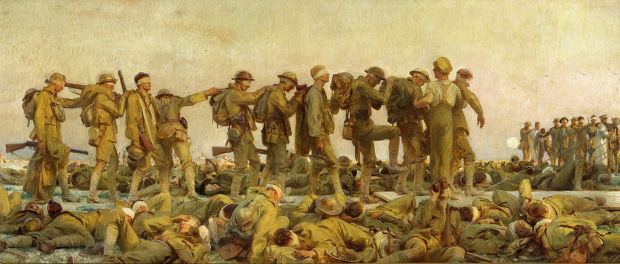Remembrance Day: 100 Years After the Great War
For the Americans, it was “the European War”, before the next world war, it was known simply as “the Great War”, but we know it today as the First World War. 2014 marks 100 years since the war, and what a legacy, what a scar it has left on the world. Its embers are left in everything from the haunting painting of John Singer Sargent’s “Gassed” (1918-19) to the comedic antics of Edmund Blackadder and Baldrick in Blackadder Goes Forth.
The propaganda of the brave soldier fighting for king and country was juxtaposed with the images of the dead and dying. The wave of initial patriotism (it was, like all wars, supposed to be over soon) quickly turned to cynicism. Technological advances made in the turn of the century made it easier to kill and easier to be killed, from the machine gun and the trench warfare to the horrors of mustard gas. With a war that lasted four years, there were more than ten million combatants killed, and seven million civilians. Millions more were wounded.
It is from this war we get the many war movies and myths. We get the near magical story of a Christmas truce between the British and the Germans, and even anecdotes about a football match. From this war we get fictional characters thrust into the events, one such example being the satirical musical Oh, What a Lovely War! which had a film version released in the late sixties. Although the film did not include the original commedia dell’arte costumes intended to show of absurdity of the war, it had the opportunity, more realistically than a stage production, to show the rows upon rows of crosses of the soldiers’ graves at the end. While these crosses were erected specially for the movie, the scene echoes the other mass graveyards across Europe of thousand dizzying markers. One cross. One soldier. Many weren’t able to receive this.
One of my teachers once recommended to the class to read Erich Maria Remarque’s All Quiet on the Western Front, a story about the Germans on the trenches. I read it in university, and how interesting it was. From the passionate rally to arms of Paul’s teacher, a pompous hypocrite who has to be drafted to go to the war himself, to Paul watching all around as his friends suffered left and right, to the ending (quite frankly, unjust, but at the same time, strangely right), I found the perspective could have come from any side: the terror and the fear of death is real and universal. This cynicism, together with an explicit anti-war message, is repeated again in the fiery writings of Henri Barbusse, in Under Fire (original French: Le feu), an autobiographical novel that both recorded his experiences on the front and started the revolution of the French novel with its use of vernacular dialogue. Its most famous episode describes an attack: they are going “over the top”, a near suicidal run over No Man’s Land to the German trenches that meant almost certain death for most.
To cease to glorify war is something that seems rather uncontentious, but this does not mean we should cease to honour veterans. I wonder for a moment what goes on in a veteran’s mind who can get to Ottawa for Remembrance Day, to hear the Taps and John McCrae’s “In Flanders Fields” set to music. I wonder what happened to those men in the trenches on that unofficial truce on Christmas day in 1914. For they risked their lives for their family, and perhaps their country, too. Or perhaps out of fear. Did they share the ideologies of their country? I wouldn’t know. But they did not start the war. They did not will it; I wouldn’t think so. Oh no, not they.
Image credit: John Singer Sargent’s “Gassed” (original dimensions: 2.30 m x 6.1 m, painted 1918-19, now in the Imperial War Museum)
Remembrance Day is November 11.






